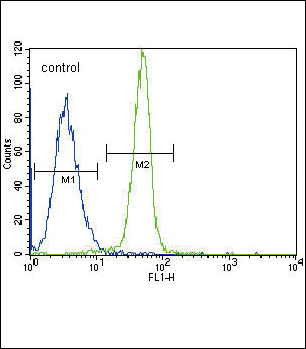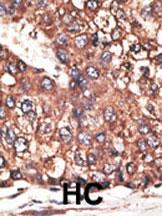Leptin Receptor (LEPR) Antibody (N-term)
Purified Rabbit Polyclonal Antibody (Pab)
- 产品详情
- 实验流程
- 背景知识
Application
| WB, FC, IHC-P, E |
|---|---|
| Primary Accession | P48357 |
| Other Accession | NP_002294 |
| Reactivity | Human, Rat, Mouse |
| Host | Rabbit |
| Clonality | Polyclonal |
| Isotype | Rabbit IgG |
| Calculated MW | 132494 Da |
| Antigen Region | 23-52 aa |
| Gene ID | 3953 |
|---|---|
| Other Names | Leptin receptor, LEP-R, HuB219, OB receptor, OB-R, CD295, LEPR, DB, OBR |
| Target/Specificity | This Leptin Receptor (LEPR) antibody is generated from rabbits immunized with a KLH conjugated synthetic peptide between 23-52 amino acids from the N-terminal region of human Leptin Receptor (LEPR). |
| Dilution | WB~~1:1000 FC~~1:10~50 IHC-P~~1:100~500 E~~Use at an assay dependent concentration. |
| Format | Purified polyclonal antibody supplied in PBS with 0.09% (W/V) sodium azide. This antibody is prepared by Saturated Ammonium Sulfate (SAS) precipitation followed by dialysis against PBS. |
| Storage | Maintain refrigerated at 2-8°C for up to 2 weeks. For long term storage store at -20°C in small aliquots to prevent freeze-thaw cycles. |
| Precautions | Leptin Receptor (LEPR) Antibody (N-term) is for research use only and not for use in diagnostic or therapeutic procedures. |
| Name | LEPR |
|---|---|
| Synonyms | DB, OBR |
| Function | Receptor for hormone LEP/leptin (Probable) (PubMed:22405007). On ligand binding, mediates LEP central and peripheral effects through the activation of different signaling pathways such as JAK2/STAT3 and MAPK cascade/FOS. In the hypothalamus, LEP acts as an appetite- regulating factor that induces a decrease in food intake and an increase in energy consumption by inducing anorexinogenic factors and suppressing orexigenic neuropeptides, also regulates bone mass and secretion of hypothalamo-pituitary-adrenal hormones (By similarity) (PubMed:9537324). In the periphery, increases basal metabolism, influences reproductive function, regulates pancreatic beta-cell function and insulin secretion, is pro-angiogenic and affects innate and adaptive immunity (PubMed:12504075, PubMed:25060689, PubMed:8805376). Control of energy homeostasis and melanocortin production (stimulation of POMC and full repression of AgRP transcription) is mediated by STAT3 signaling, whereas distinct signals regulate NPY and the control of fertility, growth and glucose homeostasis. Involved in the regulation of counter-regulatory response to hypoglycemia by inhibiting neurons of the parabrachial nucleus. Has a specific effect on T lymphocyte responses, differentially regulating the proliferation of naive and memory T -ells. Leptin increases Th1 and suppresses Th2 cytokine production (By similarity). |
| Cellular Location | Cell membrane; Single-pass type I membrane protein. Basolateral cell membrane |
| Tissue Location | Isoform A is expressed in fetal liver and in hematopoietic tissues and choroid plexus. In adults highest expression in heart, liver, small intestine, prostate and ovary. Low level in lung and kidney. Isoform B is highly expressed in hypothalamus, but also in skeletal muscle. Detected in fundic and antral epithelial cells of the gastric mucosa (PubMed:19159218). Isoform B and isoform A are expressed by NK cells (at protein level) (PubMed:12504075) |
For Research Use Only. Not For Use In Diagnostic Procedures.
Provided below are standard protocols that you may find useful for product applications.
BACKGROUND
Leptin, an adipocyte-specific hormone, regulates adipose-tissue mass through hypothalamic effects on satiety and energy expenditure by acting through the leptin receptor (LEPR). LEPR is a single-transmembrane-domain receptor of the cytokine receptor family that is identical to the mouse diabetes (db) gene product. During weight loss, leptin levels decrease, whereas soluble LEPR levels and the receptor bound fraction of leptin increases. The presence of LEPR in the absorptive cells of the small intestine suggests that leptin may have a physiological role in the regulation of nutrient absorption.
REFERENCES
Schroth, M., et al., J. Clin. Endocrinol. Metab. 88(11):5497-5501 (2003).
Couturier, C., et al., J. Biol. Chem. 278(29):26604-26611 (2003).
Gavrila, A., et al., J. Clin. Endocrinol. Metab. 88(6):2838-2843 (2003).
Yannakoulia, M., et al., J. Clin. Endocrinol. Metab. 88(4):1730-1736 (2003).
Kado, N., et al., Hum. Reprod. 18(4):715-720 (2003).
终于等到您。ABCEPTA(百远生物)抗体产品。
点击下方“我要评价 ”按钮提交您的反馈信息,您的反馈和评价是我们最宝贵的财富之一,
我们将在1-3个工作日内处理您的反馈信息。
如有疑问,联系:0512-88856768 tech-china@abcepta.com.























 癌症的基本特征包括细胞增殖、血管生成、迁移、凋亡逃避机制和细胞永生等。找到癌症发生过程中这些通路的关键标记物和对应的抗体用于检测至关重要。
癌症的基本特征包括细胞增殖、血管生成、迁移、凋亡逃避机制和细胞永生等。找到癌症发生过程中这些通路的关键标记物和对应的抗体用于检测至关重要。 为您推荐一个泛素化位点预测神器——泛素化分析工具,可以为您的蛋白的泛素化位点作出预测和评分。
为您推荐一个泛素化位点预测神器——泛素化分析工具,可以为您的蛋白的泛素化位点作出预测和评分。 细胞自噬受体图形绘图工具为你的蛋白的细胞受体结合位点作出预测和评分,识别结合到自噬通路中的蛋白是非常重要的,便于让我们理解自噬在正常生理、病理过程中的作用,如发育、细胞分化、神经退化性疾病、压力条件下、感染和癌症。
细胞自噬受体图形绘图工具为你的蛋白的细胞受体结合位点作出预测和评分,识别结合到自噬通路中的蛋白是非常重要的,便于让我们理解自噬在正常生理、病理过程中的作用,如发育、细胞分化、神经退化性疾病、压力条件下、感染和癌症。








